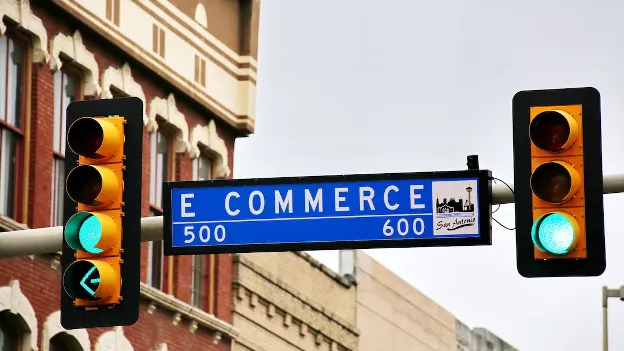SEO Strategies for Ecommerce Sites: Boosting Your Online Store's Visibility

-
Understanding the Importance of SEO for Ecommerce:
-
Choosing the Right Keywords:
-
On-Page SEO: Optimizing Your Product Pages:
-
Technical SEO: Ensuring a Smooth User Experience:
-
Building Quality Backlinks:
-
Creating Quality Content:
-
Conclusion:
Disclosure: Some of the links in this article may be affiliate links, which can provide compensation to me at no cost to you if you decide to purchase. This site is not intended to provide financial advice and is for entertainment only.
In the current digital era, running an ecommerce site without a well-planned SEO strategy is akin to opening a shop in a deserted alley: no matter how great your products are, if people can't find you, they can't buy from you. As an online store owner myself, I've ridden the rollercoaster of the SEO journey, facing its steep learning curves and celebrating its victories. Here's my story, featuring Jaaxy, a tool that became my reliable companion in this journey, along with a in-depth step-by-step guide on how to enhance your ecommerce site's visibility.
Understanding the Importance of SEO for Ecommerce:
Before diving into SEO strategies, let's understand why SEO matters for ecommerce. SEO, or Search Engine Optimization, is all about improving your website's visibility in search engines. In my journey, I quickly realized that high visibility in organic search results directly translated into more traffic and, subsequently, more sales.
In the vast ocean of the internet, SEO serves as a guiding beacon, directing potential customers towards your online store. Here's why it is of paramount importance:
Increased Visibility: SEO helps your ecommerce site rank higher in search engine results. Considering that the first page of Google captures 71-92% of search traffic clicks (that's huge!), being on that first page can dramatically increase your store's visibility. When I first started my ecommerce journey, my store was lost in the back pages of search engine results, barely receiving any organic traffic. By implementing SEO strategies, I managed to get my online store ranking on the first page for multiple keywords, substantially increasing its visibility.
Quality Traffic: SEO doesn't just boost the quantity of your traffic—it enhances its quality as well. With effective keyword research and targeting, you can attract users who are actively searching for your products. I noticed that once I started targeting relevant keywords using Jaaxy, my site started attracting visitors who were more likely to convert because they were actively looking for the products I offered.
Cost-Effective Marketing: Compared to paid advertising, SEO is a cost-effective strategy to bring in traffic. Once your site ranks high in organic search results, it can continue to attract traffic without additional advertising costs. In my experience, the return on investment (ROI) for SEO strategies was significantly higher than that of paid campaigns.
Building Trust and Credibility: A high ranking in search results signals to users that your site is relevant and trusted by search engines. This will greatly enhance your brand's credibility. I observed a notable increase in customer trust and confidence in my store once it started ranking high in search results.
Better User Experience: SEO is not just about search engines; it's also about users. Optimizing your site for SEO often means improving your site's navigation, speed, and mobile-friendliness, all of which contribute to a better user experience. As I enhanced my store's SEO, I simultaneously improved my site's user experience, which helped increase my site's dwell time and conversion rates.
Choosing the Right Keywords:
Effective SEO starts with choosing the right keywords. This task might seem daunting at first, but tools like Jaaxy make it significantly easier. Jaaxy's keyword research feature helped me identify low-competition, high-traffic keywords relevant to my products. This approach not only improved my store's visibility but also attracted quality traffic—users who were actually interested in my offerings.
Let's delve deeper into the process of choosing the right keywords for your ecommerce site:
Understanding Keyword Relevance: The first step in choosing the right keywords is understanding their relevance to your products and business. For instance, if you are selling handmade candles, keywords such as "artisanal candles" or "hand-poured scented candles" would be relevant. When I started my online store, I brainstormed a list of terms and phrases related to my products and industry, which served as my initial list of potential keywords.
Utilizing Keyword Research Tools: Using a keyword research tool like Jaaxy can take your keyword selection process to the next level. Jaaxy provides data on search volume (how many times a keyword is searched for), SEO power (how beneficial a keyword could be for SEO), and competition (how many websites are also targeting that keyword). Using Jaaxy, I was able to identify 'long-tail' keywords—longer, more specific phrases with less competition—that were highly relevant to my products and attracted a targeted audience.
Analyzing Competition: One crucial factor that Jaaxy helped me consider was the competition for each keyword. High-traffic keywords are often highly competitive, making it difficult for a new or small ecommerce site to rank for them. Instead, I focused on finding 'low-hanging fruit'—keywords with reasonable traffic but less competition. This strategy significantly improved my site's search rankings. I looked for long-tail keywords with less than 50 sites ranking for that keyword.
Considering User Intent: Not all keywords are created equal, and some will be more effective at attracting customers who are ready to buy. For example, someone searching for "affordable summer dresses" is likely closer to making a purchase than someone searching for "summer fashion trends." By targeting keywords with high purchase intent, I was able to increase my conversion rate significantly.
Continual Optimization: Finally, it's essential to remember that keyword optimization is not a one-time task. Search trends change, and so do your products and competition. With Jaaxy, I was able to continually monitor my keyword performance and adjust my strategy as needed.
Choosing the right keywords was a game-changer for my ecommerce SEO strategy. It helped me understand what potential customers were searching for, how I could get in front of them, and how I could attract those most likely to convert.
On-Page SEO: Optimizing Your Product Pages:
Once the right keywords are in your arsenal, the next step is to optimize your product pages. I learned that every product page is an opportunity to attract traffic, so treating each one as a separate landing page became my strategy. I ensured that my product descriptions, image alt text, and meta descriptions were not just interesting but also included my target keywords. Jaaxy's site analysis features were invaluable in this phase, allowing me to assess and optimize each page effectively.
Here's break down the on-page SEO process for ecommerce sites a bit further:
Product Descriptions: When I first started my ecommerce site, I made the mistake of using generic product descriptions provided by manufacturers. I quickly learned that unique and keyword-rich descriptions not only improved SEO but also added value for my customers. I started crafting descriptions that effectively highlighted the features and benefits of each product while naturally incorporating target keywords.
Title Tags and Meta Descriptions: These are vital elements of on-page SEO that appear in search engine results. They inform both search engines and potential customers about the content of the page. I ensured that each product page's title tag was unique, included the relevant keyword, and was under 60 characters (as longer titles get cut off in search results). For meta descriptions, I provided concise summaries of the product, incorporated the keyword, and kept them under 160 characters.
Image Alt Text: Alt text is used to describe images to search engines and users who can't see the image. It's an area often overlooked but can significantly boost your SEO. When adding images to my product pages, I included descriptive alt text with relevant keywords. For example, if the product was a handcrafted wooden coffee table, my alt text would be something like "handcrafted wooden coffee table with metal legs."
URL Structure: Search engines also look at URLs to understand what a page is about. So, I made sure to include my target keyword in each product page URL and kept the structure clear and straightforward, mirroring the site's hierarchy.
Internal Linking: Lastly, linking between your product pages can help distribute page authority throughout your site and provide value to your customers. For example, if I had a product that paired well with another, I would link between these two product pages.
Jaaxy's site analysis features were extremely helpful during this process, as they allowed me to monitor my on-page SEO performance and make necessary adjustments. Optimizing my product pages was a significant part of improving my online store's visibility. It was a detailed process, but the increased organic traffic and improved conversion rates made it well worth the effort.
Technical SEO: Ensuring a Smooth User Experience:
Technical SEO, while not as exciting as keyword research and on-page optimization, is equally important. It ensures your website is easily crawlable by search engines and offers users a smooth, glitch-free experience. I paid attention to elements like site speed, mobile-friendliness, and a well-structured XML sitemap, to name a few. These factors dramatically improved my store's search engine rankings, and hence its visibility.
Here's a deeper dive into the areas I focused on to enhance my online store's visibility:
Site Speed: Search engines favor websites that load quickly, and so do users. Slow loading pages can lead to high bounce rates as visitors tend to leave a site if it takes more than a few seconds to load. To improve my site speed, I worked on optimizing images, reducing the number of plugins, and enabling browser caching. I used Jaaxy's site speed feature to assess and monitor my website's load time, which helped me significantly enhance my site's performance.
Mobile-Friendliness: With the growing number of online shoppers using their mobile devices, having a mobile-friendly website is non-negotiable. I ensured that my site was responsive, meaning it automatically adjusted to fit the screen size of the device it was being viewed on. This not only improved user experience but also boosted my site's rankings, as search engines prioritize mobile-friendly sites.
XML Sitemap: An XML sitemap is essentially a roadmap of your website that helps search engines understand the structure of your site and index it more efficiently. I ensured to keep my sitemap up-to-date and submitted it to major search engines, helping them find and index all of my product pages, thus increasing their visibility.
Secure Sockets Layer (SSL): In today's digital age, online security is paramount. Having an SSL certificate for my website was crucial, not just for the security of my customers' information, but also for my SEO. Search engines favor secure websites, so switching from HTTP to HTTPS gave my site a ranking boost.
Eliminate Broken Links: Broken links lead to poor user experience and can hurt your SEO. I regularly checked my site for any broken links and either fixed or removed them. This not only improved user experience but also ensured search engines could efficiently crawl and index my site. There are pluggins that can help with this but be careful not to use to many as it can slow down your speed.
While technical SEO may seem overwhelming, especially for those with little to no coding knowledge, there are numerous tools available, like Jaaxy, that simplify the process. By taking the time to ensure your site is technically sound, you enhance user experience, making your site more attractive to both users and search engines, thereby boosting your store's visibility.
Building Quality Backlinks:
One of the biggest lessons from my SEO journey was that not all backlinks are created equal. I focused my energy on earning quality backlinks—links from reputable sites in my niche. This strategy significantly boosted my site's authority and, in turn, its search engine rankings. Tools like Jaaxy were immensely helpful in tracking my backlinks and evaluating their quality.
Building quality backlinks is an essential aspect of off-page SEO. Here's a more detailed look into how I approached this aspect:
Guest Posting: This has always been one of my favorite strategies for earning high-quality backlinks. By creating valuable content for popular blogs in my niche, I was able to attract their audience to my online store and earn a backlink in the process. Guest posting not only improved my backlink profile but also helped establish my reputation within the industry.
Influencer Partnerships: I didn't but you can also leveraged influencer marketing to earn backlinks. By partnering with influencers in your industry, You can reach a larger audience and get valuable backlinks from the influencer's website or blog.
Creating Shareable Content: One of the most organic ways to earn backlinks is by creating content that others naturally want to link to. I focused on creating high-quality, unique, and informative content that provided value to my audience and industry peers. Over time, as more and more websites linked to this content, my backlink profile grew.
Competitor Backlink Analysis: Another strategy I used was analyzing my competitors' backlink profiles. This gave me insights into where their backlinks were coming from, which websites I could potentially target, and what kind of content was earning them backlinks.
Using Social Media: Social media platforms were another useful source of backlinks. By actively sharing and promoting my content on these platforms, I was able to generate more shares, and consequently, more backlinks.
Throughout this process, Jaaxy played a crucial role. It helped me identify opportunities for guest posting and competitor analysis, track the backlinks I was earning, and assess their quality. By focusing on quality over quantity, I was able to build a strong backlink profile that significantly improved my site's authority and search engine rankings.
Creating Quality Content:
The saying "content is king" holds especially true in SEO. I made it a point to regularly publish high-quality, relevant content—be it blogs, product guides, or how-to videos. This approach not only gave me additional opportunities to rank for more keywords but also helped establish my store as a reliable source of information in my niche.
The significance of high-quality content cannot be overstated in an SEO strategy. Here's how I approached this essential element:
Blog Posts: Creating engaging blog posts was a big part of my content strategy. I leveraged Jaaxy to identify trending topics and relevant long-tail keywords within my niche. This helped me create content that was not only engaging but also capable of ranking high in search engine results. The blog posts ranged from informative articles, how-to guides, to in-depth reviews of products available in my store. This gave my audience valuable information while subtly promoting my products.
Product Descriptions: High-quality content isn't just about blog posts. It extends to every corner of your website. I invested time in crafting unique, detailed, and engaging product descriptions for each item in my store. These descriptions included my target keywords naturally and offered the potential customers all the information they would need to make a purchasing decision.
Visual Content: I also learned that visual content like infographics and videos can significantly enhance user engagement and improve SEO. I created how-to videos, product demonstrations, and appealing infographics that provided value to my customers while making my site more engaging.
User-Generated Content: Encouraging user-generated content, like customer reviews and testimonials, was another strategy I adopted. This added an element of social proof to my website, improved its credibility, and provided fresh, unique content that search engines love.
Content Optimization: Creating quality content is half the battle won; the other half involves optimizing it for search engines. Every piece of content I produced was carefully optimized with relevant keywords, structured for readability, and paired with meta tags and descriptions.
While generating consistent, high-quality content requires time and effort, it was an investment that yielded excellent results. Not only did it help my ecommerce site rank higher in search engine results, but it also established my store as an authoritative and reliable source of information within my niche. This combination significantly boosted my website traffic and conversion rates.
Conclusion:
Improving your ecommerce site's visibility through SEO is a continuous process of learning, implementing, analyzing, and optimizing. In my journey, tools likeJaaxy proved to be an essential asset, simplifying complex tasks and providing actionable insights. Whether you're a newbie in the digital space or an experienced player, I hope my experience and the strategies I shared will help you navigate your SEO journey and propel your online store to new heights of success.
-
Understanding the Importance of SEO for Ecommerce:
-
Choosing the Right Keywords:
-
On-Page SEO: Optimizing Your Product Pages:
-
Technical SEO: Ensuring a Smooth User Experience:
-
Building Quality Backlinks:
-
Creating Quality Content:
-
Conclusion:
Disclosure: Some of the links in this article may be affiliate links, which can provide compensation to me at no cost to you if you decide to purchase. This site is not intended to provide financial advice and is for entertainment only.






